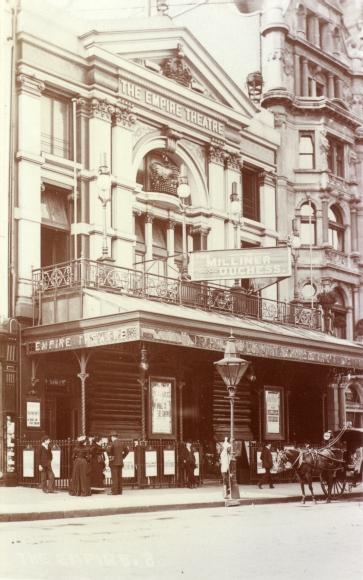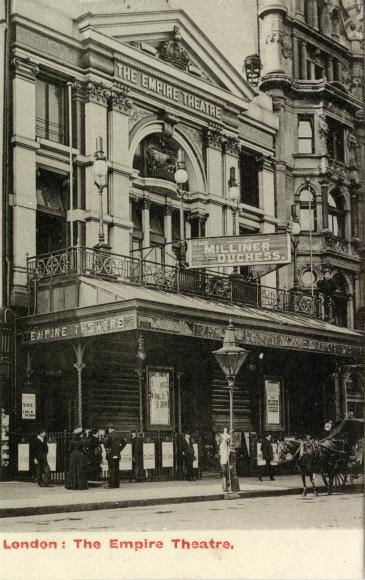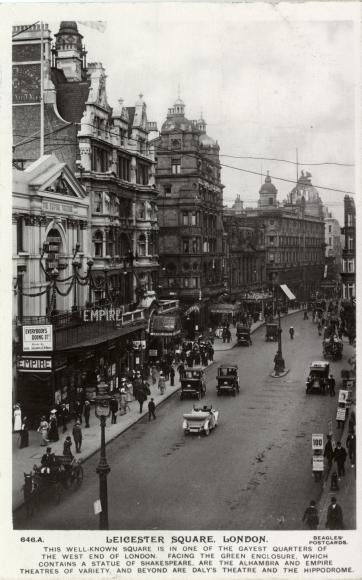Empire
The history of the site and the buildings which have occupied or been planned for it is extremely complex. The Survey of London (Vol XXXIV) account is full and authorative. Saville House, formerly Aylesbury House of 1684, which stood here, was used for various exhibitions and entertainments from the first years of the nineteenth century. The SOL volume notes that between 1846 and 1865 various parts of the house were given 14 different names. Burnt down in 1865, plans for theatres on the site included the Denmark Theatre & Winter Garden and the Alcazar Grand Theatre of Varieties. What was eventually built was the Royal London Panorama. Thomas Verity prepared plans for the conversion of the panorama into a theatre but the work was delayed and completed by another architect. Names proposed for the new theatre were Plaza, Phoenix, Pandora and Queens, but it opened in 1884 as the Empire Theatre.
The subsequent, eventful history of this building is well recorded in histories of music hall & English ballet. After a brilliant career it closed in 1927, was almost entirely rebuilt and reopened as a cinema. Since the 1962 reconstruction its theatrical interest is slight and there is nothing left to recall the extraordinary history of the first Empire and its notorious promenade. Parts of the external structure are remnants of the Frank Verity works (notably on the West side). The Empire of 1928 was the only cinema in Britain constructed to designs by the American specialist Thomas Lamb. The elevation is closely based on his Albee Theatre in Cincinnati, built a year earlier. The deep portico is the only surviving element of his work. The auditorium was the biggest ever seen in the West End, and the most opulent constructed in the inter-war period. Its programming matched this pre-eminence, and not just by showing the latest films. In 1949, a bid to combat changes in film-going and licensing, alterations were made so that elaborate shows could be staged in accompaniment to the feature film. The Empire Girls, Empire Ballet and Empire Concert Orchestra, together with well-known variety acts, had a brief but spectacular life until March 1952. After a further major reconstruction it reopened in 1962 with a ballroom in the old stalls area and a new stadium cinema in the former circle and foyer. The Ritz cinema next door became a subsidiary auditorium reached by a common entrance.
- 1884 - 1961
Further details
- Owner/Management: See Diana Howard op.cit.
- 1884 Design/Construction:Thomas Verity (succeeded by J & A E Bull)- Architect
- 1884 - 1961 Use:
- 1887 Alteration: redecoratedRomaine Walker & Tanner- Architect
- 1899 Alteration: new foyer & secondary entranceFrank Verity- Architect
- 1904 Alteration: major reconstructionFrank Verity- Architect
- 1925 Owner/Management: MGM
- 1928 Alteration: re-built as a cinema theatreThomas W Lamb with Frank Matcham Co (F G M Chancellor)- Architect
- 1962 Alteration: completely reconstructed as cinema and ballroomGeorge Coles- Architect
- 1980 - 1989 Owner/Management: early CIC
- 1989 Owner/Management: UCI (CIC trading name)
- 2005 Owner/Management: Empire Cinemas Ltd, owner
- CapacityOriginalDescription1884: 3000
- CapacityLaterDescription1912: 1726
1928: 3000 - CapacityCurrentDescription1330
- ListingNot listed




